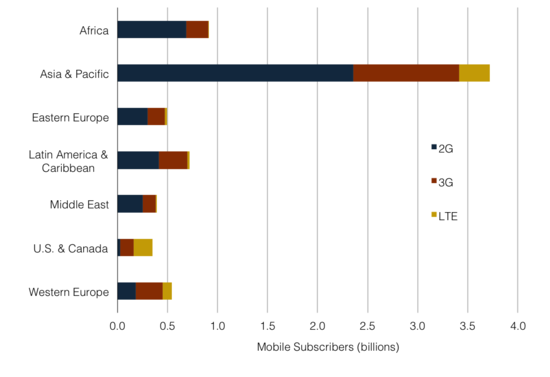You might argue it is a good thing that global mobile adoption will pass 100 percent of earth's population by the end of 2015. In one sense, it is a positive milestone.
In another sense, it points to market saturation, and the end of the ability to drive revenue growth by adding human accounts. Once everybody has at least one active phone and account, growth comes partly by convincing people to connect additional devices and use more services.
Eventually, the industry encounters the paucity of truly-huge basic demand, however. Though "everybody" might want to talk, send messages and use the Internet, the clearly-understood and truly-big demand for products beyond that is limited.
That is why so much activity in the fixed network market over the past decade has been "selling more things to fewer customers." The same dynamic will develop in the mobile business, assuming competition remains a key market reality.
Global mobile subscribers reached 7.1 billion so far in 2015, up from just seven million in 1989, and will surpass the number of people on earth by the end of the year, says TeleGeography.
As has been the case for some years, Asia has the greatest number of subscribers, with 3.7 billion. Also, as has been the recent trend, Asia represents the subscriber growth driver, globally.
Between the first quarter of 2014 and the same quarter of 2015, Asia added 194 million new accounts, representing more than 60 percent of net new accounts globally.
But saturation looms. Although more than 270 million people in the region do not have a mobile phone, that could, at present rates, reach nearly zero within two years.
The immediate revenue growth driver now becomes mobile Internet services. In that regard, India is key. Some 90 percent of Indian mobile subscribers use 2G networks.
Africa also represents growth. Mobile adoption there is 81 percent, while 2G remains the dominant platform, used by 75 percent of the continent’s 912 million subscribers.
 |
| Mobile Subscribers by Region, Q1 2015, source TeleGeography |
European mobile adoption stands at 138 percent, representing one billion accounts. But the actual number of mobile subscribers actually fell by six million over the last year.
North American wireless penetration is expected to reach 100 percent.
The point is that mobile services will reach saturation within the next few years, with revenue growth driven by mobile Internet access.
The big challenge beyond that is how to fuel growth when mobile Internet reaches saturation.
Mobile service providers globally are turning their sights to services used by sensors and controllers.
Having first exhausted markets for mobile voice, then messaging, and now focusing on mobile Internet access, future growth in services for humans might be quite difficult.
Telemetry is the next big potential growth driver.
